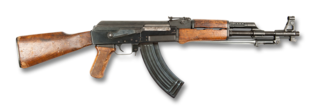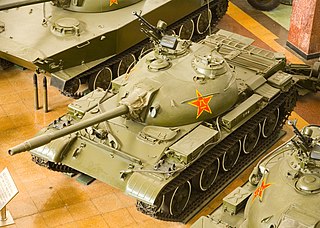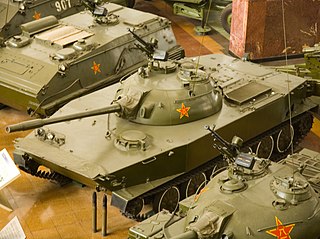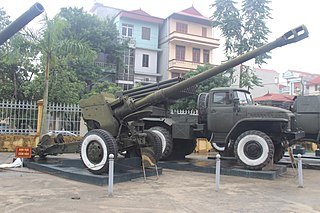Users
 Cambodia
Cambodia  China – in reserve
China – in reserve Democratic Republic of the Congo [1]
Democratic Republic of the Congo [1]  Egypt
Egypt  Iran [2]
Iran [2]  Sri Lanka
Sri Lanka  Sudan
Sudan  Zimbabwe
Zimbabwe
| Type 60 | |
|---|---|
| Type | Field gun |
| Place of origin | China |
| Service history | |
| Used by | See Users |
| Wars | Vietnam War Cambodian Civil War Sino-Soviet border conflict Indo-Pakistani War of 1965 Six-Day War Sino-Indian War Sino-Vietnamese War Yom Kippur War Sri Lankan civil war |
| Specifications | |
| Mass | 5,620 kg (12,390 lb) |
| Length | N/A |
| Crew | 7–9 |
| Caliber | 122 mm (4.8 in) |
| Breech | Horizontal sliding-wedge |
| Carriage | Type 60 |
| Elevation | +45/−5 degree |
| Traverse | +/−29 degree |
| Rate of fire | Intense 8–10 rounds/min |
| Muzzle velocity | 885 m/s (2,900 ft/s) |
| Effective firing range | 23.9 km (14.9 mi) (indirect) 1,080 m (1,180 yd) (direct) |
| Maximum firing range | 24 km (15 mi) |
The Type 60 122mm towed gun is the Soviet D-74 122mm gun produced by the Chinese under licence. Developed in the late 1950s, it provided direct fire and indirect fire for the People's Liberation Army (PLA). It remains in service with reserve units in gun battalions attached to motorized infantry and armoured divisions. It is in active service with the Sri Lankan Army, introduced in the early 1990s to replace the Ordnance QF 25 pounder field gun. It has seen action in the Sri Lankan civil war.

The T-54 and T-55 tanks are a series of Soviet medium tanks introduced in the years following the Second World War. The first T-54 prototype was completed at Nizhny Tagil by the end of 1945. From the late 1950s, the T-54 eventually became the main tank for armoured units of the Soviet Army, armies of the Warsaw Pact countries, and many others. T-54s and T-55s have been involved in many of the world's armed conflicts since their introduction in the second half of the 20th century.

The Type 59 main battle tank is a Chinese-produced version of the Soviet T-54A tank, an early model of the ubiquitous T-54/55 series. The first vehicles were produced in 1958 and it was accepted into service in 1959, with serial production beginning in 1963. Over 9,500 of the tanks were produced by the time production ended in 1985 with approximately 5,500 serving with the Chinese armed forces. The tank formed the backbone of the Chinese People's Liberation Army armoured units until the early 2000s, with an estimated 5,000 of the later Type 59-I and Type 59-II variants in service in 2002.

The Type 56 is a Chinese 7.62×39mm automatic rifle, a licensed derivative of the Soviet-designed AK-47.

The ZPU is a family of towed anti-aircraft guns based on the Soviet 14.5×114mm KPV heavy machine gun. It entered service with the Soviet Union in 1949 and is used by over 50 countries worldwide.

The BTR-40 is a Soviet open-topped, wheeled armoured personnel carrier and reconnaissance vehicle. It is often referred to as the Sorokovka in Soviet service. It was eventually replaced in the APC role by the BTR-152 and in the scout car role by the BRDM-1.

The 122-mm howitzer D-30 is a Soviet howitzer that first entered service in 1960. It is a robust piece that focuses on the essential features of a towed field gun suitable for all conditions. The D-30 has a maximum range of 15.4 km (9.6 mi) or 21.9 km (13.6 mi) using rocket-assisted projectile ammunition.

The Type 69 85mm RPG, made by Norinco, is a Chinese variant of the Soviet RPG-7. First introduced in 1972, the Type 69 is a common individual anti-tank weapon in service with the PLA. More advanced grenade rounds were developed in the 1980s and 1990s to meet the requirements of modern battlefields. Eventually, the aging Type 69 RPG family was replaced by more modern anti-tank weapon systems developed by China such as the Type 89 and Type 08.

The Norinco Type 62 is a Chinese light tank developed in the early 1960s, based on the Chinese Type 59 with a reduced main gun calibre, lighter armour and a smaller suite of electronics and other equipment to help reduce weight. Bearing in mind that the Chinese Type 59 is essentially the Soviet T-54, its reduction the Type 62 with its 85 mm cannon and wedgy little turret is clearly reminiscent of the hull-predecessor of the T-54 which is T-44-85, which turret and gun are from the T-34-85. The Type 62 is retired from the Chinese People's Liberation Army Ground Forces, but is still in use with other nations. It had recently been upgraded to modern standards and to provide the PLA with a dedicated light tank. It is also known under its industrial designation, WZ-131.

The Norinco Type 63 is a Chinese amphibious light tank. First fielded in 1963, it is in many ways similar to the earlier Soviet PT-76. However, contrary to the popular belief, it does have some essential differences from the PT-76 in the vehicle's waterjet propulsion system, etc. It is also known under its industrial designation, the WZ-211. Type 63 is being replaced by Type 63A.

The Type 63 is a Chinese armoured personnel carrier that entered service in the late 1960s. It was the first armoured vehicle designed in China without Soviet assistance. The design is simple and is comparable to other APCs of its time such as the M113.

AZP S-60 is a Soviet towed, road-transportable, short- to medium-range, single-barrel anti-aircraft gun from the 1950s. The gun was extensively used in Warsaw Pact, Middle Eastern and Southeast Asian countries.

The 130 mm towed field gun M-46 is a manually loaded, towed 130 mm artillery piece, manufactured in the Soviet Union in the 1950s. It was first observed by the West in 1954.

The 152 mm gun-howitzer M1955, also known as the D-20, is a manually loaded, towed 152 mm gun-howitzer artillery piece, manufactured in the Soviet Union during the 1950s. It was first observed by the West in 1955, at which time it was designated the M1955. Its GRAU index is 52-P-546.

The M1943 Mortar or 120-PM-43 or the 120-mm mortar Model 1943, also known as the SAMOVAR, is a Soviet 120 millimeter calibre smoothbore mortar first introduced in 1943 as a modified version of the M1938 mortar. It virtually replaced the M1938 as the standard weapon for mortar batteries in all Soviet infantry battalions by the late 1980s, though the armies of the Warsaw Pact utilised both in their forces.

The RPD is a 7.62x39mm light machine gun developed in the Soviet Union by Vasily Degtyaryov for the 7.62×39mm M43 intermediate cartridge. It was created as a replacement for the DP machine gun chambered for the 7.62×54mmR round. It is a precursor of most squad automatic weapons. It was succeeded in Soviet service by the RPK.

The Type 66 is a 152 mm towed howitzer used by the People's Liberation Army of China. The gun system is developed from the Soviet D-20 towed artillery. In addition to conventional shells the gun is capable of firing Type MP-152 rocket-assisted projectiles. In some cases a gun-shield is fitted but this is not universal.

The 85-mm divisional gun D-44 was a Soviet divisional 85-mm calibre field artillery gun used in the last action of World War II. It was designed as the replacement for the 76 mm divisional gun M1942 (ZiS-3). The gun was no longer in front-line service with the Russian Ground Forces, until being pressed back into service in the Russo-Ukrainian War in 2023. Wartime service included use by communist forces during the Vietnam War and by Arab forces during their conflicts with Israel.

The Type 38 10 cm cannon was a field gun used by the Imperial Japanese Army during World War I, the Second Sino-Japanese War and World War II. It was a licensed copy of a 1905 Krupp design. The Type 38 designation was given to this gun as it was accepted in the 38th year of Emperor Meiji's reign (1905). By 1941 it was thoroughly obsolete and relegated to second-line service.

The 122mm D-74 towed gun is a Soviet field gun. Developed in the late 1940s, it served with the Soviet Army and was widely exported. A number were produced under license in the People's Republic of China as the Type 60.

The Type 80 is a general-purpose machine gun (GPMG) manufactured by Norinco in China, based on the Soviet PKM. The machine gun was certified for design finalisation in 1980 and entered the PLA service in the mid-1980s, specifically in 1983. The Type 80 was intended as a successor to the Chinese independently developed Type 67, doing well in tests conducted in the Chengdu Military Region before it was dropped and instead, opted to keep the Type 67 GPMG in use.